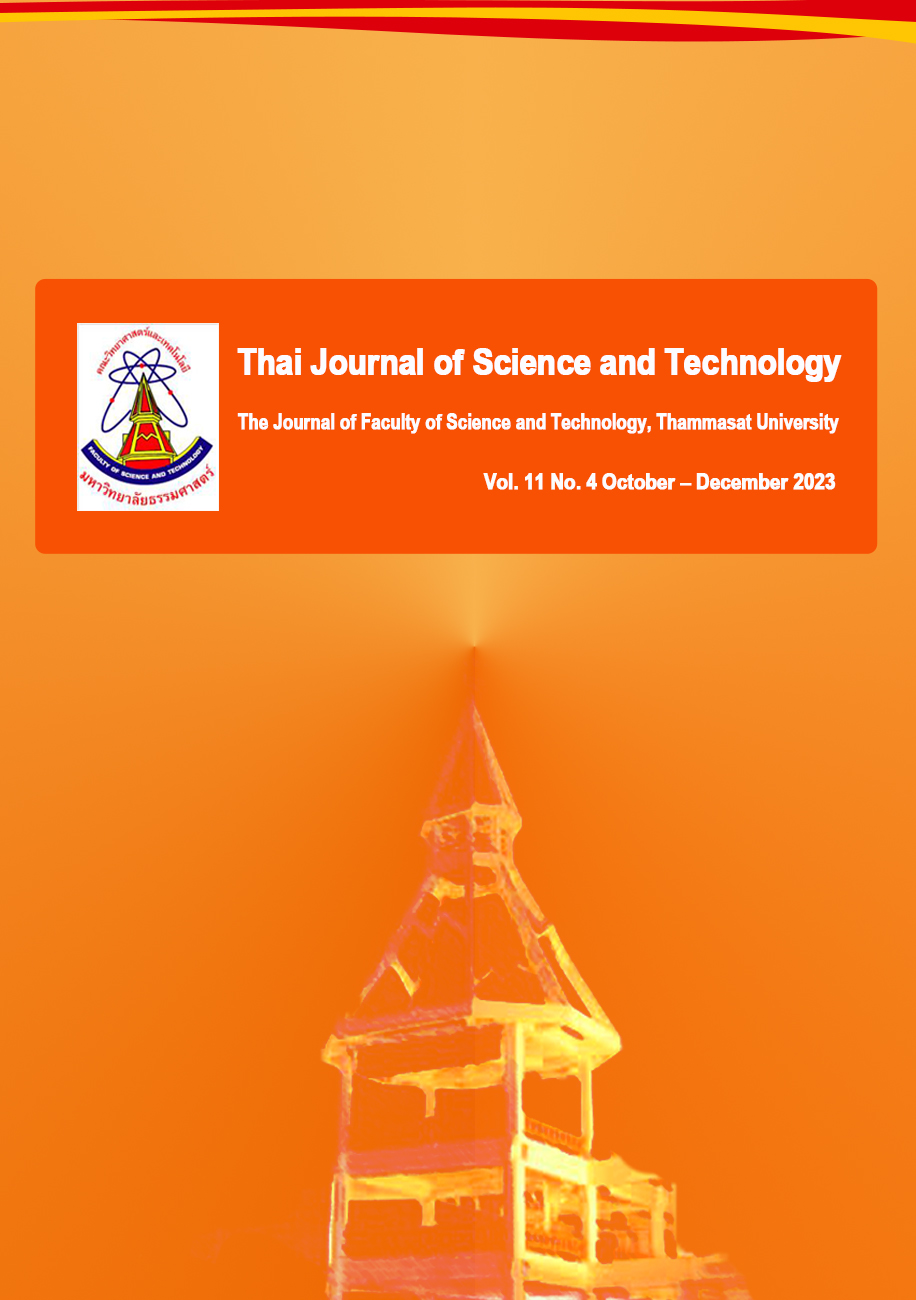Anatomical Character of Aglaia cucullata (Roxb.) Pellegr., a Medicinal Plant Found in Mangrove Forest of Thailand
Main Article Content
Abstract
Aglaia cucullata is the sole member of the genus Aglaia that is regarded as a true mangrove species. The plant was discovered in the mangrove forest of Thailand's peninsular region. Anatomical structure has a significant impact on how a plant functions and adapts to its environment. The plant samples were collected from Tha Pom Klong Song Nam, Krabi province, a mangrove forest of Thailand. The materials were processed into permanent slides using a paraffin method, a sliding microtome technique and scanning electron microscopic technique. The anatomical characters of root, stem, petiole, petiolule, rachis, leaf and wood were investigated. The results revealed that the vascular system of the petiole and petiolule are heart-shaped, whereas the rachis appears concave shaped on both sides. These features are essential for taxonomic identification. Additionally, the multiseriate aseptate peltate trichomes discovered in this study are also exclusive to this genus. Anatomically, multiple palisade mesophyll, tanninferous cells and crystals were are observed. The results of this study revealed that anatomical traits can be used to certify the species and to understand how the plant adapts its structure to survive in severe environment.
Article Details

This work is licensed under a Creative Commons Attribution-NonCommercial-NoDerivatives 4.0 International License.
บทความที่ได้รับการตีพิมพ์เป็นลิขสิทธิ์ของคณะวิทยาศาสตร์และเทคโนโลยี มหาวิทยาลัยธรรมศาสตร์ ข้อความที่ปรากฏในแต่ละเรื่องของวารสารเล่มนี้เป็นเพียงความเห็นส่วนตัวของผู้เขียน ไม่มีความเกี่ยวข้องกับคณะวิทยาศาสตร์และเทคโนโลยี หรือคณาจารย์ท่านอื่นในมหาวิทยาลัยธรรมศาสตร์ ผู้เขียนต้องยืนยันว่าความรับผิดชอบต่อทุกข้อความที่นำเสนอไว้ในบทความของตน หากมีข้อผิดพลาดหรือความไม่ถูกต้องใด ๆ
References
Gomes, D.M.S., & Neves, L.J. (2009). Scanning electron microscopy of the leaf epidermis of Merostachys Spreng. (Poaceae: Bambusoideae). Acta Botanica Brasilica, 23(2), 516-525.
Heads, M. (2019). Biogeography and ecology in a pantropical family, the Meliaceae. The Gardens’ Bulletin Singapore, 71, 335-461.
Howard, R.A. (1970). Some observations on the nodes of woody plants with special reference to the problem of the “split-lateral” versus the “common gap”. Botanical Journal of the Linnean Society, 1, 195-214.
Khaopakro, S., Vajrodaya, S., Siripatanadilok, S., & Kermanee, P. (2015). Wood anatomical survey and wood specific gravity of 13 species of Aglaia (Meliaceae) from Thailand. Thai Forest Bulletin (Botany), 43, 87-103.
Liakopoulos, G., Stavrianakou, S., & Karabourniotis, G. (2006). Trichome layers versus dehaired lamina of Olea europaea leaves: differences in flavonoid distribution, UV-absorbing capacity and wax yield. Environmental and Experimental Botany, 55, 294–304.
Liakoura, V., Stefanou, M., Manetas, Y., Cholevas, C., & Karabourniotis, G. (1997). Trichome density and its UV-B protective potential are affected by shading and leaf position on the canopy. Environmental and Experimental Botany, 38, 223–229.
Long, H.S., Tilney, P.M., & Van Wyk, B.-E. (2010). The ethnobotany and pharmacognosy of Olea europaea subsp. africana (Oleaceae). South African Journal of Botany, 76, 324–331.
Mabberley, D.J. (1995). Meliaceae. (Aglaia by C.M. Pannell). In: Dassanayake, M.D., Fosberg, F.R. and Clayton W.A. (eds), A revised handbook to the Flora of Ceylon 9: 228-300. Location: New Delhi: Amerind Publishing, New Delhi, India.
Mabberley, D.J. (2011). Meliaceae. In: K. Kubitzki (eds), The Families and Genera of vascular plants 10: 185–211. Location: Springer. Verlag Berlin Heidelberg, Germany.
Mabberley, D.J., Pannell, C.M., Edmonds J.M., & Sing, A.M. (2007). Meliaceae. In: E. Soepadmo, L.G. Saw and R.C.K. Chung (eds), Tree Flora of Sabah and Sarawak 6: 17–218. Location: Forest Resarch Institue Malaysia, Kepong, Malaysia.
Martínez-Cabrera, D., Terrazas, T., & Ocholerena, H. (2009). Foliar and petiole anatomy of tribe Hameliaeae and other Rubiaceae. Annals of Missouri Botanical Garden, 96(1), 133-145.
Metcalfe, C.R., & Chalk, L. (1950). Anatomy of the dicotyledons, vol 2. Oxford Claredon Press. Location: Oxford, UK.
Moraes, T.M.S., Rabelo, G.R., Alexandrino, C.R., Silva-Neto, S.J.S., & Cunha, M. (2011). Comparative leaf anatomy and micromorphology of Psychotria species (Rubiaceae) from the Atlantic Rainforest. Acta Botânica Brasílica, 25(1), 178-190.
Muellner, A.N., Samuel, R., Chase, M.W., Pannell, C.M., & Greger, H. (2005). Aglaia (Meliaceae): an evaluation of taxonomic concepts based on DNA data and secondary metabolites. American Journal of Botany, 92(3), 534–543.
Muellner, A.N., Pannell, C.M., Coleman, A., & Chase, M.W. (2008, The origin and evolution of Indomalesian, Australasian and Pacific island biotas: insights from Aglaieae (Meliaceae, Sapindales). Journal of Biogeography, 35,1769–1789.
Pannell, C.M. (1992). A taxonomic monograph of the genus Aglaia Lour. (Meliaceae), Kew Bulletin Additional Series XVI. HMSO. Location: London, UK.
Pervin, R., Afrin, S., Sabrin, F., Zohora, U.S., Rahman, M.S., Islam, K.D., & Billah, Md.M. (2016). Antioxidant, Antibacterial and Brine Shrimp Lethality Bioassay of Amoora cucullata, a Mangrove Plant. Journal of Young Pharmacists, 8(1), 33-38.
Rahman, M.S., & Rashid, M.A. (2009). Preliminary antimicrobial and cytotoxic activities of Amoora cucullata extractives. Oriental Pharmacy and Experimental Medicine, 9, 182–185.
Rahman, M.S., Chowdhury, R., Begum, B., Rahman, K.M., & Rashid, M.A. (2005). Phytochemical Studies of Amoora cucullate. Dhaka University Journal of Pharmaceutical Sciences, 4(1), 1816-1839.
Rao, S.R.S., & Ramayya, N. (1982). Taxonomic importance of epidermal characters in the Indian Thespesia Corr. (Malvaceae). Proceedings / Indian Academy of Sciences, 91, 509–517.
Rodrigues, L.C.A., Castro, E.M., Pereira, F.J., Maluleque, I.F., Barbosa, J.P.R.A.D., & Rosado, S.C.S. (2016). Effects of paclobutrazol on leaf anatomy and gas exchange of Toona ciliata clones. Australian Forestry, 79(4), 241-247.
Tadavi, S.C., & Bhadane, V.V. (2014). Taxonomic Significance of the Rachis, Petiole and Petiolule Anatomy in some Euphorbiaceae. Biolife, 2(3), 850-857.
Teixeira, T.R., Pádua, M.S., & Castro, A.H.S. (2016). Leaf anatomy of Cordiera sessilis (Vell.) Kuntze (Rubiaceae). Acta Scientiarum, 38(3), 355-364.
Werker, E. (2000). Trichome diversity and development, In Hallahan, D. L., and Gray, J. C. (Eds.), Plant Trichomes. Advances in Botanical Research (p. 1-30). Location: Academic Press, London, UK.
Wongprasert, T., Phengklai, C., & Boonthavikoon, T. (2011). A synoptic account of the Meliaceae of Thailand. Thai Forest Bulletin (Botany), 39, 210–266.
Xu, W.H., Su, X.M., Wang, C., Du, F., & Liang, Q. (2019). The genus Amoora: A phytochemical and pharmacological review. Fitoterapia, 137, 1-13.


